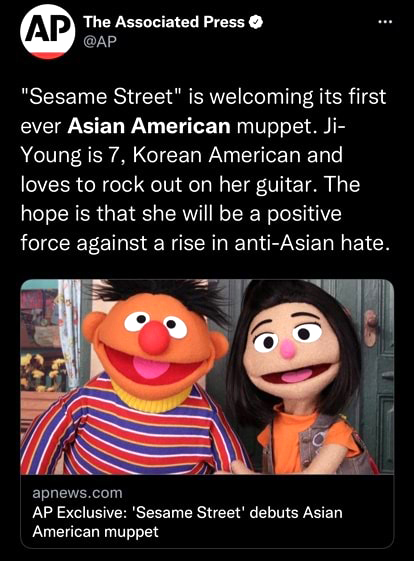By TERRY TANG

What’s in a name? Well, for Ji-Young, the newest muppet resident of “Sesame Street,” her name is a sign she was meant to live there.
“So, in Korean traditionally the two syllables they each mean something different and Ji means, like, smart or wise. And Young means, like, brave or courageous and strong,” Ji-Young explained during a recent interview. “But we were looking it up and guess what? Ji also means sesame.”
At only 7 years old, Ji-Young is making history as the first Asian American muppet in the “Sesame Street” canon. She is Korean American and has two passions: rocking out on her electric guitar and skateboarding. The children’s TV program, which first aired 52 years ago this month, gave The Associated Press a first look at its adorable new occupant.
Ji-Young will formally be introduced in “See Us Coming Together: A Sesame Street Special.” Simu Liu, Padma Lakshmi and Naomi Osaka are among the celebrities appearing in the special, which will drop Thanksgiving Day on HBO Max, “Sesame Street” social media platforms and on local PBS stations.
Some of Ji-Young’s personality comes from her puppeteer. Kathleen Kim, 41 and Korean American, got into puppetry in her 30s. In 2014, she was accepted into a “Sesame Street” workshop. That evolved into a mentorship and becoming part of the team the following year. Being a puppeteer on a show Kim watched growing up was a dream come true. But helping shape an original muppet is a whole other feat.
“I feel like I have a lot of weight that maybe I’m putting on myself to teach these lessons and to be this representative that I did not have as a kid,” Kim said. But fellow puppeteer Leslie Carrara-Rudolph—who performs Abby Cadabby—reminded her, “It’s not about us … It’s about this message.”
Ji-Young’s existence is the culmination of a lot of discussions after the events of 2020—George Floyd’s death and anti-Asian hate incidents. Like a lot of companies, “Sesame Street” reflected on how it could “meet the moment,” said Kay Wilson Stallings, executive vice-president of Creative and Production for Sesame Workshop, the nonprofit organization behind “Sesame Street.”
Sesame Workshop established two task forces—one to look at its content and another to look at its own diversity. What developed was Coming Together, a multi-year initiative addressing how to talk to children about race, ethnicity and culture.
One result was 8-year-old Tamir. While not the show’s first Black muppet, he was one of the first used to talk about subjects like racism.
“When we knew we were going to be doing this work that was going to focus on the Asian and Pacific Islanders experience, we of course knew we needed to create an Asian muppet as well,” Stallings said.
These newer muppets—their personalities and their looks—were remarkably constructed in a matter of months. The process normally takes at least a couple of years. There are outside experts and a cross-section of employees known as the “culture trust” who weigh in on every aspect of a new muppet, Stallings said.
For Kim, it was crucial that Ji-Young not be “generically pan-Asian.”
“Because that’s something that all Asian Americans have experienced. They kind of want to lump us into this monolithic ‘Asian,’” Kim said. “So it was very important that she was specifically Korean American, not just like, generically Korean, but she was born here.”
One thing Ji-Young will help teach children is how to be a good “upstander.” “Sesame Street” first used the term on its “The Power of We” TV special last year, which featured Tamir.
“Being an upstander means you point out things that are wrong or something that someone does or says that is based on their negative attitude towards the person because of the color of their skin or the language they speak or where they’re from,” Stallings said. “We want our audience to understand they can be upstanders.”
In “See Us Coming Together,” Sesame Street is preparing for Neighbor Day where everyone shares food, music or dance from their culture. Ji-Young becomes upset after a kid, off screen, tells her “to go back home,” an insult commonly flung at Asian Americans and Pacific Islanders. But she feels empowered after Sesame Street’s other Asian American residents, guest stars and friends like Elmo assure her that she belongs as much as anyone else.



